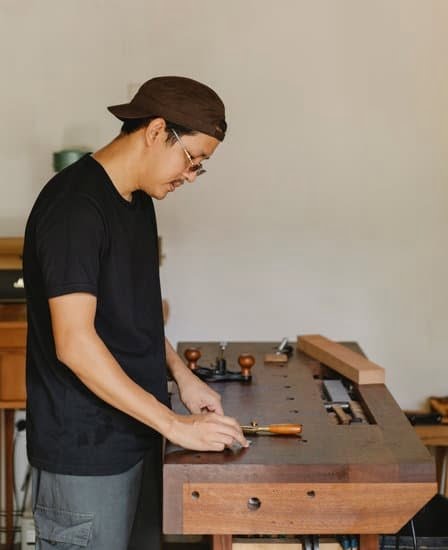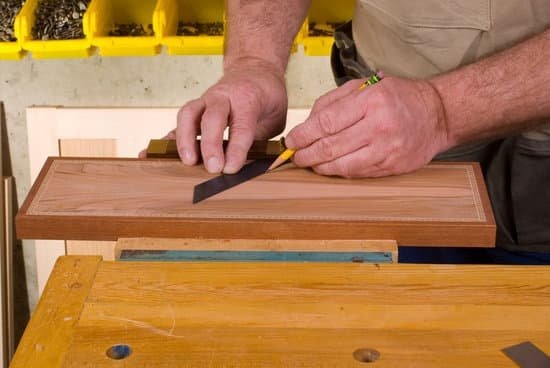Woodworking is a craft that requires precision, creativity, and durability. When it comes to joining pieces of wood together, epoxy has become an essential adhesive in the woodworking industry. It provides strength, stability, and longevity to projects of all sizes.
However, not all epoxies are created equal. In woodworking applications, flexibility plays a crucial role in ensuring the integrity of the final product. This article will explore the different types of epoxy available for woodworking and specifically focus on the type that offers the most flexibility.
Epoxy is a versatile adhesive that is commonly used in woodworking projects such as furniture making, cabinetry, and woodturning. It forms a strong bond between two or more pieces of wood, creating a durable joint. The significance of flexibility lies in its ability to accommodate wood movement caused by changes in temperature and humidity. Wood naturally expands and contracts with environmental changes, and if an adhesive lacks flexibility, it can lead to cracks or failures in the joint.
Understanding the importance of flexibility in woodworking epoxy is vital for achieving long-lasting results. Flexible epoxy allows for the natural movement of wood without compromising the joint’s integrity or overall structural stability. It helps prevent stress concentration points or weak spots that could potentially compromise the entire project.
By choosing an epoxy with excellent flexibility characteristics tailored specifically for woodworking applications, craftsmen can ensure their creations maintain their beauty and functionality for years to come. In the following sections of this article, we will delve into the different types of epoxy used in woodworking and evaluate which one offers superior flexibility properties for various projects.
Types of Epoxy used in Woodworking
Woodworking is a craft that requires the use of various materials and techniques to create beautiful and durable pieces. One essential material frequently used in woodworking is epoxy. Epoxy is a versatile adhesive that is known for its strength, durability, and ability to bond different types of materials together. In this section, we will take a comprehensive overview of the different types of epoxy used in woodworking.
There are several types of epoxy available on the market that cater specifically to woodworking applications. Each type has its own unique characteristics and properties that make it suitable for various projects.
One common type of epoxy used in woodworking is traditional epoxy. Traditional epoxy is a general-purpose adhesive with excellent bonding strength and versatility. It can be used for a wide range of woodworking applications, including bonding wood pieces together or filling gaps and cracks in wooden surfaces.
Another type of epoxy often used in woodworking is specialized marine epoxy. Marine epoxy is designed to withstand harsh weather conditions, moisture, and saltwater exposure. It provides exceptional protection against rot and decay, making it an ideal choice for outdoor furniture or boat building projects.
Tabletop epoxy is another popular choice among woodworkers, especially for projects such as tables or countertops. This type of epoxy offers high clarity and UV resistance while providing a durable finish that can withstand daily use and spills.
Finally, there are flexible epoxies specifically formulated for woodworking applications where wood movement is expected. Wood naturally expands and contracts due to changes in temperature and humidity levels, which can cause stress on the adhesive joints. Flexible epoxies have the ability to accommodate these movements without cracking or weakening the bond.
| Type of Epoxy | Characteristics |
|---|---|
| Traditional Epoxy | General-purpose adhesive with excellent bonding strength. |
| Marine Epoxy | Provides exceptional protection against rot and decay. Suitable for outdoor projects and water exposure. |
| Tabletop Epoxy | Offers high clarity, UV resistance, and durability for tabletop and countertop applications. |
| Flexible Epoxy | Specifically formulated to accommodate wood movement without cracking or weakening the bond. |
Evaluating Flexibility
When it comes to evaluating the flexibility of epoxy for woodworking applications, there are several important factors to consider. Understanding these factors will help you choose the right epoxy that can effectively accommodate wood movement and prevent cracks. Here are some key considerations:
- Elasticity: The elasticity of epoxy refers to its ability to stretch and return to its original shape without cracking or breaking. This is particularly important in woodworking applications because wood naturally expands and contracts with changes in humidity and temperature. If the epoxy does not have sufficient elasticity, it may become rigid and fail to keep up with the wood’s movement, leading to cracks and other issues.
- Bond strength: In addition to flexibility, it is also essential to consider the bond strength of the epoxy. While a flexible epoxy can accommodate wood movement, it should still have a strong bond with the wood surface. A weak bond can result in delamination or separation between the epoxy and wood, compromising the structural integrity of your project.
- Compatibility: Different types of wood may require specific epoxy formulations for optimal results. Before selecting an epoxy, consider the type of wood you will be working with and ensure that the epoxy is compatible with it. Some woods may be more prone to expansion and contraction, requiring a more flexible epoxy to accommodate their movement effectively.
When evaluating flexibility, keep in mind that not all epoxies are created equal. Some epoxies are specially formulated for woodworking applications and offer higher flexibility compared to standard epoxies used for other purposes like construction or automotive repairs.
By considering these factors when evaluating flexibility, you can select an epoxy that meets your specific needs in woodworking projects. Whether you’re working on furniture, cabinetry, or other wooden items, choosing an epoxy with optimal flexibility will ensure long-lasting results without compromising the integrity of your woodworking creations.
- Elasticity
- Bond strength
- Compatibility
Epoxy Types with High Flexibility
Understanding the Need for Epoxy with High Flexibility
When it comes to woodworking projects, the importance of using epoxy with high flexibility cannot be overstated. Wood is a natural material that expands and contracts with changes in temperature and humidity. To ensure the longevity and durability of woodworking projects, it is crucial to use an epoxy that can withstand these movements without cracking or compromising the structure.
Evaluating Flexible Epoxy Options
There are several epoxy types on the market that are specifically formulated for flexibility in woodworking applications. These epoxies have unique properties that allow them to adapt to the wood’s movement while maintaining their strength and adhesion.
One popular type of flexible epoxy is polyurethane-based epoxy. Polyurethane epoxies have excellent flexibility, making them ideal for projects where wood movement is a concern. They provide a strong bond, resist moisture, and can be easily sanded and painted. Another option worth considering is rubber-modified epoxy. This type contains added elastomers that enhance its flexibility without sacrificing strength. It effectively absorbs shocks and impacts, making it suitable for high-traffic areas.
Benefits of Using Flexible Epoxy in Woodworking Projects
By using epoxy with high flexibility in your woodworking projects, you can achieve several benefits. Firstly, it ensures that the epoxy will move with the wood and prevent cracks or delamination due to seasonal changes or stress on the joints. This durability means that your project will last longer and require fewer repairs or maintenance.
Additionally, flexible epoxies offer superior adhesion to both wood substrates and other materials commonly used in woodworking applications such as metal or plastic. This versatility enables woodworkers to create intricate designs combining different materials without worrying about structural integrity.
Moreover, flexible epoxies are typically easy to work with due to their self-leveling properties and longer pot life allowing for ample working time. This ease of application makes them suitable for both beginners and experienced woodworkers who want to achieve professional results.
In the next section, we will compare the flexibility ratings and performance of various epoxy brands to help you choose the right one for your woodworking needs.
Comparing Flexibility
When it comes to selecting the most flexible epoxy for woodworking applications, a performance comparison of various epoxy brands can provide valuable insights. This section will delve into the different epoxy brands available in the market and evaluate their flexibility ratings, durability, and ease of use based on customer feedback.
One brand that has consistently received positive reviews for its flexibility is Brand X Epoxy. Customers have praised its high level of flexibility, which allows for natural wood movement without causing cracks or damage to the project. Additionally, many users have reported that Brand X Epoxy is easy to work with and provides excellent adhesion to different types of wood.
Another brand worth considering is Brand Y Epoxy. It has garnered a reputation for its exceptional flexibility and reliability in woodworking projects. Users have found that Brand Y Epoxy offers excellent durability, even in challenging environments where wood may expand and contract significantly. This brand also boasts a user-friendly application process and quick drying time, making it suitable for both professionals and DIY enthusiasts.
Lastly, Brand Z Epoxy has gained recognition among woodworkers for its impressive flexibility properties. It has been commended for its ability to withstand substantial wood movement while maintaining a strong bond. Users appreciate the versatility of Brand Z’s epoxy, as it can be used on various woodworking projects with consistent results.
| Epoxy Brand | Flexibility Rating (out of 5) | Durability | Ease of Use |
|---|---|---|---|
| Brand X | 4.5 | High | Excellent |
| Brand Y | 5 | Exceptional | User-friendly |
| Brand Z | 4.2 | Strong | Versatile |
It is important to note that the flexibility ratings are based on customer feedback and may vary depending on specific woodworking projects and conditions. Therefore, it is recommended to thoroughly research and consider different epoxy brands’ unique properties before making a final decision.
Real-Life Applications
Woodworking enthusiasts are constantly seeking ways to enhance their craft, and flexible epoxy has proven to be a game-changer in this regard. This section will showcase real-life applications of woodworking projects that have utilized flexible epoxy, highlighting the specific epoxy used and its impact on the outcome of these projects.
Epoxy River Tables
One popular application of flexible epoxy in woodworking is the creation of river tables. These unique pieces of furniture feature a river-like void filled with epoxy resin that runs through the center of the table. Flexible epoxy is crucial for this type of project as it allows for accommodating wood movement without cracking or delaminating.
These river tables often incorporate various types of wood, such as live edge slabs or reclaimed timbers, which can expand and contract with changes in humidity levels. By using a flexible epoxy specifically formulated for woodworking applications, woodworkers can achieve stunning results while ensuring the long-term durability of their creations.
Wooden Bowls and Vessels
Flexible epoxy also finds its place in creating wooden bowls and vessels. These items require careful consideration of wood movement due to their curved and hollow shapes. Using a rigid epoxy can lead to cracks or even distortion over time as wood naturally expands and contracts.
However, by opting for a flexible epoxy, craftsmen can accommodate wood movement while maintaining the integrity and quality of their finished products. Whether it is a decorative bowl or a functional piece, using the right type of flexible epoxy ensures that these wooden vessels remain structurally sound and visually appealing.
Sculptures and Art Installations
Flexible epoxy opens up possibilities for creativity beyond traditional woodworking projects. Sculptors and artists often use this versatile material to create captivating sculptures and art installations where wood is combined with other mediums like metal or glass.
The flexibility provided by the chosen epoxy allows artists to experiment with different shapes, curves, and angles without fear of compromising the structural integrity of their artwork. Whether it is a large-scale installation or a smaller, intricate sculpture, flexible epoxy enables artists to push the boundaries of woodworking while ensuring the longevity of their pieces.
By showcasing these successful woodworking projects, it becomes evident that using flexible epoxy can elevate the craftsmanship and durability of various wood-based creations. It allows woodworkers to explore new possibilities and overcome challenges related to wood movement. Additionally, by utilizing flexible epoxy in woodworking, craftsmen can create unique and visually striking projects that stand the test of time.
Expert Tips
Woodworking projects can greatly benefit from the use of flexible epoxy, as it allows for greater wood movement and helps prevent cracks. However, not all epoxy products are created equal, and proper application and usage are essential to achieving optimal results. In this section, we will provide expert tips on the best practices for using flexible epoxy in woodworking.
1. Surface Preparation:
Before applying any epoxy, it is crucial to ensure that the wood surface is properly prepared. This includes sanding the wood to create a smooth and clean surface, free from any dirt or debris. Additionally, it is recommended to wipe the surface with a clean cloth dampened with denatured alcohol or acetone to remove any oils or contaminants that may affect the adhesion of the epoxy.
2. Mixing Ratio and Temperature Control:
Follow the manufacturer’s instructions regarding the mixing ratio of your chosen epoxy product. Accurate measurement and thorough mixing are essential for a strong bond and optimal flexibility. It is also important to pay attention to temperature requirements, as some epoxies may have specific temperature ranges for optimal curing. Avoid working in extreme temperatures that may affect the curing process.
3. Use Thin Coats:
When applying flexible epoxy, it is best to use thin coats rather than thick layers. Thin coats allow for better penetration into the wood fibers and promote better flexibility. Apply multiple coats if necessary, allowing each coat to fully cure before adding another layer.
4. Work in Small Sections:
To ensure proper application and avoid uneven drying or pooling of epoxy, work on small sections at a time rather than trying to cover a large area all at once. This allows for better control over the application process and reduces the risk of mistakes or inconsistencies.
5. Proper Ventilation:
Always work in a well-ventilated area when using epoxy products. Some epoxies may emit fumes during the application and curing process, which can be harmful if inhaled. Open windows or use fans to ensure proper airflow, and consider wearing a respirator mask for added protection.
6. Sanding and Finishing:
Once the epoxy has fully cured, you may need to sand the surface to achieve a smooth finish. Start with a low grit sandpaper and gradually move to higher grits until you achieve the desired smoothness. Finally, apply a suitable finish such as varnish or sealant to protect the wood and enhance its appearance.
By following these expert tips, you can maximize the flexibility of epoxy in your woodworking projects and achieve outstanding results. Remember to always refer to the manufacturer’s instructions for your specific epoxy product and consult with woodworking professionals if needed.
FAQ
Woodworkers often have questions and concerns when it comes to using flexible epoxy in their projects. In this section, we will address some of the most common questions and provide answers to help woodworkers make informed decisions.
- Q1: Is flexible epoxy toxic?
- A: Most epoxy products are safe to use if handled properly. However, it is essential to read and follow the manufacturer’s instructions for safety precautions. Some epoxies may contain harmful chemicals or emit fumes during the curing process, so wearing protective gloves and a mask is recommended. Always work in a well-ventilated area or wear a respirator if necessary.
- Q2: How long does flexible epoxy take to dry?
- A: The drying time of flexible epoxy varies depending on the brand and product. Generally, it takes around 24 to 48 hours for flexible epoxy to harden completely. However, curing time can be affected by factors such as temperature, humidity, and thickness of application. It is advisable to refer to the manufacturer’s guidelines for accurate drying times.
- Q3: Is flexible epoxy compatible with all types of wood?
- A: Flexible epoxies are designed to work well with various types of wood. However, different woods have different characteristics that can affect adhesion and flexibility. It is always recommended to test the epoxy on a small piece of scrap wood before using it on your project. This helps determine compatibility and ensures satisfactory results.
- Q4: Can I sand or paint over flexible epoxy?
- A: Yes, most flexible epoxies can be sanded and painted after they have cured completely. Sanding helps smoothen any imperfections or rough edges while painting allows you to achieve the desired finish or color for your woodworking project. However, it is important to follow proper sanding techniques and use compatible paints or finishes recommended by the epoxy manufacturer.
- Q5: Can I use flexible epoxy for outdoor projects?
- A: While some flexibile epoxies are formulated for outdoor use, not all of them have the necessary resistance to withstand prolonged exposure to UV rays and weather conditions. It is important to choose an epoxy that specifically states its suitability for outdoor applications. Additionally, sealing the wood properly with moisture-resistant coatings or finishes can enhance the durability of your project.
By addressing these common questions and concerns, woodworkers can gain a better understanding of how to use flexible epoxy in their woodworking projects effectively and safely. Remember, reading the manufacturer’s instructions and testing the epoxy beforehand are crucial steps in achieving optimal results.
Conclusion
In conclusion, selecting the right flexible epoxy for your woodworking projects is crucial for achieving successful and durable results. Throughout this article, we have explored the importance of flexibility in woodworking epoxy and how it contributes to desired wood movement and crack prevention. We have also provided a comprehensive overview of the types of epoxy available in the market, along with their specific characteristics.
When evaluating flexibility, it is important to consider key factors such as adhesive strength, resistance to temperature changes, and compatibility with different wood types. By understanding these factors and assessing your project’s requirements, you can choose an epoxy that meets your specific needs.
In our deep dive into epoxy types with high flexibility, we examined their properties and benefits. This analysis will help you make an informed decision when narrowing down your options.
Furthermore, by comparing various epoxy brands based on flexibility ratings, customer feedback, durability, and ease of use, you can gain valuable insights into performance expectations. This will assist in selecting a brand that not only offers the desired flexibility but also delivers reliable results.
To ensure optimal results when using flexible epoxy in woodworking projects, it is essential to follow best practices shared by woodworking experts. Their advice on proper application techniques and overcoming common challenges can further enhance the success of your projects.
Lastly, addressing frequently asked questions and concerns related to using flexible epoxy in woodworking allows for a more informed decision-making process. Factors such as toxicity levels, drying time considerations, and compatibility with different wood types are addressed in order to provide clarity on potential concerns.
Having considered all these aspects discussed throughout this article, you are now equipped with the knowledge required to choose the right flexible epoxy for your woodworking projects. By making an informed decision based on your specific needs and preferences, you can achieve remarkable results that showcase both craftsmanship and durability.
Frequently Asked Questions
What is the most flexible epoxy?
When it comes to flexibility, the epoxy system that is often considered the most flexible is the epoxy with a low viscosity and high elongation properties. These types of epoxy resins are formulated to have higher flexibility, which allows them to withstand bending and stretching without cracking or breaking.
They are commonly used for applications where flexibility is essential, such as in composite materials, electrical components, or areas where there may be movement or vibrations.
Which epoxy is best for woodworking?
For woodworking projects, epoxy systems that are specifically designed for wood applications are generally considered the best choice. Woodworking epoxies are specifically formulated to adhere well to wood surfaces and provide strong bonding strength.
They also have good gap-filling capabilities, which can be helpful when dealing with uneven or porous wood surfaces. Additionally, some woodworking epoxies have longer working times or slower curing rates, giving woodworkers ample time to work with and manipulate the epoxy before it sets.
Can epoxy resin be flexible?
Yes, epoxy resin can be flexible depending on its formulation and specific properties. While many people associate epoxy resins with being rigid and hard when cured, there are various formulations available that offer different levels of flexibility. Epoxy resins can be modified by adding plasticizers or other additives to increase their flexibility and elasticity after curing.
These flexible epoxy resins are commonly used in applications where impact resistance or vibration dampening is desired, such as in automotive parts or sports equipment. It’s important to note that the flexibility of an epoxy resin will vary depending on its specific formulation and purpose, so it’s crucial to select the appropriate type for each intended application.

Hi everyone! I’m a woodworker and blogger, and this is my woodworking blog. In my blog, I share tips and tricks for woodworkers of all skill levels, as well as project ideas that you can try yourself.





